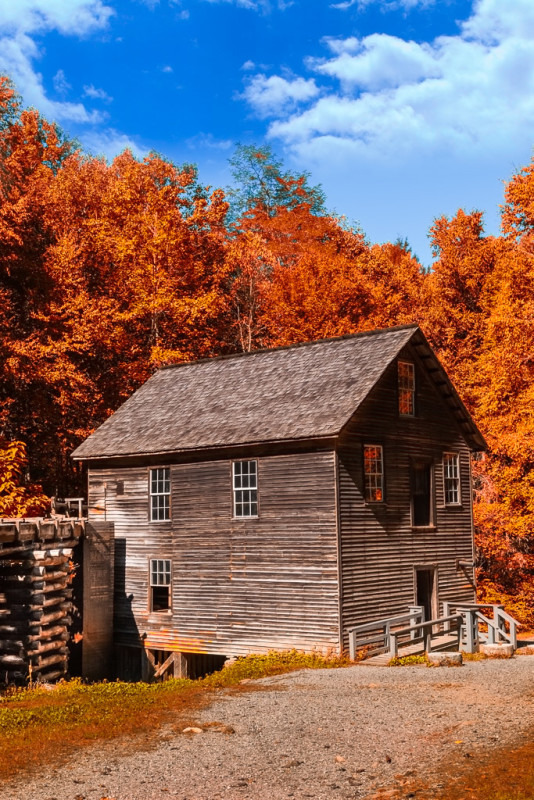
This is another image I made during my recent trip to the Smoky Mountains. The mill was built in 1886, was completed in three months, cost $600 to construct, and still stands today at its original site. What is interesting about this mill is how it operates. When I think of gristmills, I usually think of buildings with large rotating water wheels on the side that provide the power that operates the grinding equipment. However, this mill used a water turbine instead of a traditional water wheel. The water turbine made the mill more efficient and required less water to mill the grain, but it is certainly not what I think of when I think of gristmills. I am sure most people feel the same way.
One of the things I was hoping to capture during this trip was the autumn color change. I estimated that in the three to four weeks leading up to my trip, the weather would have surely been cooler in eastern Tennessee than it was at my home. The cooler temperatures would cause the leaves to start changing, and I could photograph the mill with some nice fall color on the trees in the background.
Unfortunately, when I arrived, I found my assumption was completely wrong. The leaves were nowhere close to beginning their annual transformation. They were as green as ever, so I knew I was not going to get the image I had originally envisioned. Even the sky was clear blue without a hint of a cloud. But, I thought I might be able to do a little something with it once I got home.
After I did the basic processing in Lightroom, I was still less than impressed. I still had a picture of a mill against a clear blue sky and green-leafed trees. If nothing else, I knew I had to change the sky. Fortunately, I have taken pictures of nothing but the sky in various situations – clear skies with puffy white clouds, skies with faint wisps of clouds lit by sunrise or sunset lighting, skies with dark, stormy clouds – for just this purpose. To do this, I opened the image in Photoshop, went into my sky folder and selected a picture was similar in lighting and tonality to the main image. This selection is very important because if the lighting and tonality are not similar, the final photograph will not look right.
To substitute the new sky for the old one, I selected the entire sky picture, copied it, and then pasted it over the image of the mill creating a second layer. I applied a layer mask and used the gradient tool to remove the portion of the sky photograph that covered the bottom area of the mill. It took a little while to get just the right gradient, but once that I was done, I used the brush tool to clean up a few small areas of clouds that were still covering the trees.
I still wasn’t completely satisfied because the leaves on the trees were still green, and I wanted autumn color. I wasn’t sure exactly how to accomplish this until I stumbled upon a solution: Color Efex Pro from the Google Nik Collection, which provides numerous sets of filters than can make a photograph look absolutely stunning. As I began to experiment with these filters, I clicked on one called Indian Summer and was immediately amazed. As soon as I clicked on the filter, the leaves changed to a bright orange color. Even the reflections of the leaves in the windows changed. I played around with the filter for a few minutes tweaking the various setting and sliders until I finally got what I had originally visualized – an image of Mingus Mill surrounded by fall foliage.
Settings: Canon 5D Mk45mm, 1/160 sec, f/11